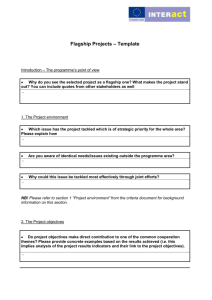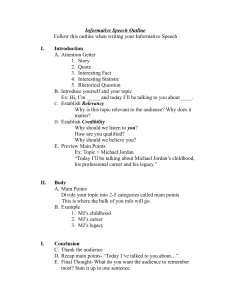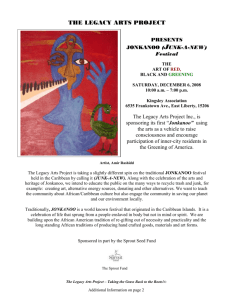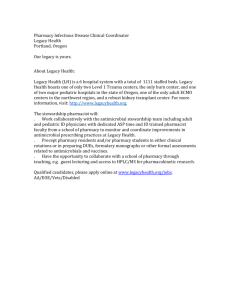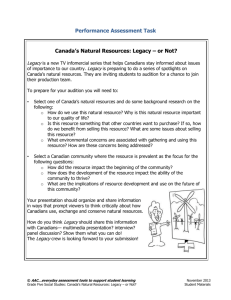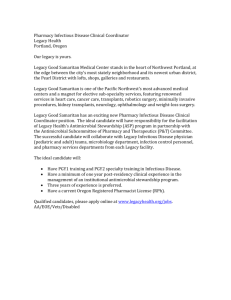Initiating The Legacy Conversation And Getting To
advertisement
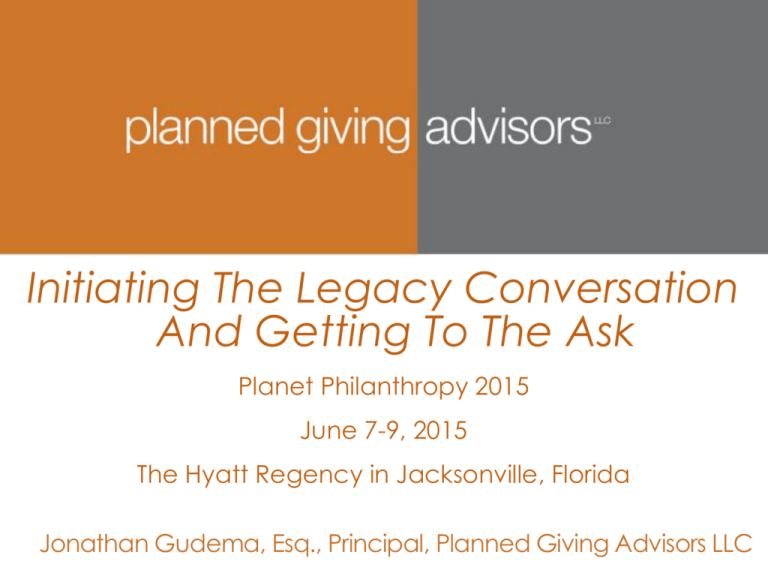
Initiating The Legacy Conversation And Getting To The Ask Planet Philanthropy 2015 June 7-9, 2015 The Hyatt Regency in Jacksonville, Florida Jonathan Gudema, Esq., Principal, Planned Giving Advisors LLC What we’ll cover today Why Legacy Giving for your organization? Who do you need to be initiating conversations with? What do you need in place to get started? What are the key concepts for legacy conversations? How do you prep your prospects? How do you start the actual Legacy conversation? How do you lead initial conversations to a closed gift? 2 Why Legacy Giving for your organization? America is aging So is your database! Baby boomers are moving into retirement years Generation X’ers and Y’ers are not poised to replaced their contribution dollars 3 The Future of Nonprofits 4 The Future of Nonprofits “…over-reliance by nonprofits on just “keeping the lights on” is a short sighted strategy that steadily erodes the long-term survival of the organization. As important as annual giving campaigns are in the fundraising practices of the nonprofit sector, developing a steady stream of sustained long-term financial security deserves at least equal – if not the greater – priority.” It Matters…But Is It Working? A White Paper Series on Our Region’s Nonprofit Sector Fiscal Health & Sustainability The Philadelphia Foundation, July 2010 5 Revenue Potential Charitable Bequests represent Since 1971 7.7% 6 Of all U.S. Fundraising Revenue Potential IRS data over 10 years (19871997) showed that 2.7 times their lifetime charitable giving in their estates 7 On average left Estate tax payers who left charitable bequests So-Called Giving Life Cycle Major Giving Annual Giving 8 Capital Giving Legacy Giving Reality Annual Giving or Major Giving 9 Legacy Giving Why Planned Giving? Inflation Adjusted U.S. Giving 1972-2013 $ in billions 350 300 What changed? 250 200 150 100 1972 1977 Inflation adjusted dollars Source: Giving USA 2014 10 1982 1987 1992 1997 2002 2007 2012 Why Planned Giving? Individual Giving as a Percentage of Disposable Personal Income 4.0% 3.5% 3.0% 2.5% 2.4% 2.2% 1.9% 2.0% 1.5% 1.0% 0.5% 0.0% 1972 1977 1982 Adjusted for Inflation, in current Dollars Source: Giving USA 2014 11 1987 1992 1997 2002 2007 2012 Why Planned Giving? Inflation Adjusted U.S. Giving 1972-2013 $ in billions 350 300 1991 Oldest Boomers Age 45 Youngest Boomers Age 27 2011 Oldest Boomers Age 65 Youngest Boomers Age 47 250 200 150 100 1972 1977 Inflation adjusted dollars Source: Giving USA 2014 12 1982 1987 1992 1997 2002 2007 2012 Why Planned Giving? U.S. Non-Farm Employment 1972-2013 in thousands 130,000 110,000 90,000 70,000 Source: U.S. Bureau of Labor Statistics 13 Why Planned Giving? 13.0 % of US Population Over 65 -- 2010 Maine Washington Vermont Minnesota Montana North Dakota Massachuttes Oregon Wisconsin South Dakota Idaho Illinois Kansas Kentucky Oklahoma Arizona New Mexico Alaska 8.1% Texas Hawaii Source: U.S. Census Bureau Virginia Georgia Alabama Louisiana 5.7% - 9% 9.1% - 13% 13.1% - 17% 17%+ New Jersey Delaware Maryland South Carolina Arkansas Mississippi West Virginia North Carolina Tennessee California 14 Indiana Missouri Rhode Island Connecticut Ohio Nevada Colorado Michigan Iowa Nebraska Utah New York Pennsylvania Wyoming New Hampshire Florida 17.8% Why Planned Giving? 14.5% of US Population Over 65 -- 2015 Maine Washington Vermont Minnesota Montana North Dakota Massachuttes Oregon Wisconsin South Dakota Idaho Utah 10.1% Kansas Indiana Kentucky Missouri Oklahoma Arizona New Mexico Virginia Georgia Alabama Alaska Texas Hawaii Source: U.S. Census Bureau 15 Louisiana 5.7% - 9% 9.1% - 13% 13.1% - 17% 17%+ New Jersey Delaware Maryland South Carolina Arkansas Mississippi West Virginia North Carolina Tennessee California Rhode Island Connecticut Ohio Illinois Colorado Michigan Iowa Nebraska Nevada New York Pennsylvania Wyoming New Hampshire Florida 19.5% Why Planned Giving? 16.3% of US Population Over 65 -- 2020 Maine Washington Vermont Minnesota Montana North Dakota Massachuttes Oregon Wisconsin South Dakota Idaho Colorado Kansas Indiana Kentucky Missouri Oklahoma Arizona New Mexico Virginia Georgia Alabama Alaska Texas Hawaii Source: U.S. Census Bureau 16 Louisiana 5.7% - 9% 9.1% - 13% 13.1% - 17% 17%+ New Jersey Delaware Maryland South Carolina Arkansas Mississippi West Virginia North Carolina Tennessee California Rhode Island Connecticut Ohio Illinois Utah 11.4% Michigan Iowa Nebraska Nevada New York Pennsylvania Wyoming New Hampshire Florida 21.8% Why Planned Giving? 18.2% of US Population Over 65 -- 2025 Maine Washington Vermont Minnesota Montana North Dakota Massachuttes Oregon Wisconsin South Dakota Idaho Colorado Kansas Indiana Kentucky Missouri Oklahoma Arizona New Mexico Virginia Georgia Alabama Alaska Texas Hawaii Source: U.S. Census Bureau 17 Louisiana 5.7% - 9% 9.1% - 13% 13.1% - 17% 17%+ New Jersey Delaware Maryland South Carolina Arkansas Mississippi West Virginia North Carolina Tennessee California Rhode Island Connecticut Ohio Illinois Utah 12.6% Michigan Iowa Nebraska Nevada New York Pennsylvania Wyoming New Hampshire Florida 24.7% Why Planned Giving? 19.7% of US Population Over 65 -- 2030 Maine Washington Vermont Minnesota Montana North Dakota Massachuttes Oregon Wisconsin South Dakota Idaho Colorado Kansas Indiana Kentucky Missouri Oklahoma Arizona New Mexico Virginia Georgia Alabama Alaska Texas Hawaii Source: U.S. Census Bureau 18 Louisiana 5.7% - 9% 9.1% - 13% 13.1% - 17% 17%+ New Jersey Delaware Maryland South Carolina Arkansas Mississippi West Virginia North Carolina Tennessee California Rhode Island Connecticut Ohio Illinois Utah 13.2% Michigan Iowa Nebraska Nevada New York Pennsylvania Wyoming New Hampshire Florida 27.1% Why Planned Giving? Non-Bequest $ $ in billions Bequest $ 450 2011 – Oldest Baby Boomers reach age 65 400 350 2018 – Oldest Baby Boomers reach age 72 1996 – Oldest Baby Boomers reach age 50 300 250 200 150 100 50 0 1990 19 1994 1998 Source: Giving USA 2002 2006 2010 2014 2018 2022 2026 2030 Who do you need to be initiating conversations with? Who are most likely to include your nonprofit in their estate plans alongside family and loved one? Long-term givers or volunteers? Alumni or beneficiaries of your services? Retired staff or local community? Who are the people you can identify who have the highest likelihood to go from supporter/friend to family/legacy? 20 Top Ten Predictors of Charitable Bequests I. # years giving VII. Not married II. No offspring VIII. Last reported giving III. Highest levels of giving IX. Growing wealth IV. Funded living trust X. V. # years volunteering Female VI. Last reported wealth 21 Source: Russell James, J.D., Ph.D., CFP®, Webainar “Wills That Won’t”, 2014 Who Leave Charitable Bequests? Data Confirms that Wealth Ranked Donors Are Strong Prospects 22 % Leaving Charitable Bequests Population Segment 4%-5% Everyone 10% Givers of $500 or more annually to charities 20% Moderately wealthy passing away with $3.5 million to $10 million 28% Pretty wealthy passing away with $10 million to $20 million 40% Very wealthy passing away with over $20 million in assets Sources: IRS Data as reported in Giving USA 2012, Russell N. James III, J.D., PH.D. Boomers Differ From Their Predecessors Think about the differences between those age 68 and younger versus those just a few years older… Women’s liberation movement Women started having more successful careers Having children later, if at all Much higher divorce rates Generally smaller families 23 U.S. Pop. Age 55+ Charitable Estates Among Those With Will or Trust by Family Status 55% 50% 45% 40% Grandchildren 35% Children only 30% No Offspring (unmarried) No Offspring (married) 25% 20% 15% 10% 5% 1998 2000 2002 2004 2006 2008 2010 2012p Source: Russell James, J.D., Ph.D., CFP®, Webainar “Wills That Won’t”, 2014 U.S. Childlessness Rates Women Ages 40-44 21.0% 20.4% 19.0% 19.0% 17.5% 17.0% 16.0% 15.0% 13.0% 11.4% 11.0% 9.0% 10.2% 10.1% 8.6% 7.0% 1970 1975 1980 1985 1990 1995 2000 2005 Current Ages: (85-89) (80-84) (75-80) (70-74) (65-69) (60-64) (55-59) (50-54) 25 Source: U.S. Census Bureau/U.S. Bureau of Labor Statistics Birth Year: 26 2,300,000 1928 (age 87) 1926 (age 89) 1924 (age 91) 1922 (age 93) Today’s PG $ Source: U.S. Census Bureau/U.S. Bureau of Labor Statistics 1950 (age 65) 1948 (age 67) 1946 (age 69) 1944 (age 71) 1942 (age 73) Today’s PG Prospects! 1968 (age 47) 1966 (age 49) 1964 (age 51) 1962 (age 53) 1960 (age 55) 1958 (age 57) 1956 (age 59) 1954 (age 61) 1952 (age 63) 2,700,000 1940 (age 75) 2,900,000 1938 (age 77) 3,100,000 Bust Years 3,300,000 1936 (age 79) 3,500,000 1934 (age 81) 1932 (age 83) 1930 (age 85) 3,700,000 Boom Years Current Age: 1920 (age 95) What Wealth Transfer? # U.S. Births 4,300,000 4,100,000 3,900,000 2,500,000 What do you need in place to get started? Legacy society or other “tool” for initiating conversations Clear reasons why supporters should want to take this big step Staff and board commitment to long-term nature of planned giving Campaign or other time incentive for pushing people to commitment 27 What are the key concepts for legacy conversations? Less than 50% of Americans have any estate planning documents And that percentage is increasing with Baby Boomers! Why is there such a big gap between donor and bequests donors? Generally, only about 10% of your decent donors will include your org in their estate plans What about our big planned giving failures? 28 How many times do we see boards refusing to push planned gifts among its members? How many times have seen beautiful planned giving mailings produce barely any response from a clearly ripe audience! What the What you see subconscious sees Seminar Tonight: Estate Planning Seminar Tonight: Your Upcoming Death What are the key concepts for legacy conversations? Brain reaction studies confirm: What is 1st-stage defense to death reminders/one’s mortality? AVOIDANCE (1st stage defense) Distract Differentiate Deny Delay Depart How do we sidestep avoidance? 30 Inside the Mind of the Planned Giving Donor, Profession Russell James, 2013 What are the key concepts for legacy conversations? Brain reaction studies confirm: How do we sidestep avoidance? Donor organ donation question in Europe: Opt-in – Want to donate your organs? MOST SAID NO Opt-out – Want to opt out of organ donation program – MOST SAID NO How about mixed packaging? Help us secure our future good works (like we are doing today) through joining our Legacy campaign (or society or whatever) Try sidestepping direct death reminder with carefully designed Legacy message that emphasizes other things besides direct death reminders 31 Inside the Mind of the Planned Giving Donor, Profession Russell James, 2013 What are the key concepts for legacy conversations? Brain reaction studies confirm: In any case, it may not be us who have to break through 1st stage avoidance It could be: Illness Injury Advancing age Death of a family member Intentionally planning for one’s death through estate planning Keep in mind that your prospect may already be beyond 1st stage avoidance 32 Inside the Mind of the Planned Giving Donor, Profession Russell James, 2013 2nd stage defense to death reminders: Symbolic immortality Supporting and being remembered by one’s surviving “in-group” I will die, but my values, beliefs, story will live on, through my influence and support of my “ingroup” [family, interest group, community] Permanence is psychologically attractive Something reflecting the person’s life story (community and values) Will live beyond them H What are the key concepts for legacy conversations? Brain reaction studies confirm: Bequest decision making emphasizes “visualized autobiography” brain regions Bequests to friends/family engage “memory and emotion” brain regions more than charitable bequests 2nd-stage defense to death reminders is to seek symbolic immortality or “autobiographical heroism” by supporting one’s “in-group” community Some part of one’s self – one’s name, family, community, achievements, values, goals, etc… – will persist after death. Leave a Legacy that will be remembered 35 Inside the Mind of the Planned Giving Donor, Profession Russell James, 2013 What are the key concepts for legacy conversations? Brain reaction studies confirm: Tell life stories of donors who will live beyond their death through bequest giving – PREFERABLE FROM LIVING INDIVIDUALS Remind donors of life story connections of friends/family with the charity/cause through tribute bequest opportunities Emotion and memory stronger with family/friends Connect that emotion/memory to a your prospect’s legacy gift “Permanence” bolsters the message 36 Inside the Mind of the Planned Giving Donor, Profession Russell James, 2013 What are the key concepts for legacy conversations? Brain reaction studies confirm: Add something to get prospects from YES to NOW Time limits Matching gift time limit Campaign time limit Participation time limit 37 Inside the Mind of the Planned Giving Donor, Profession Russell James, 2013 What are the key concepts for legacy conversations? Brain reaction studies confirm: 38 Visualized Biography Family Emotion Avoidance Symbolic Immortality 1 2 3 4 Life Stories Tribute Bequests Mixed Packaging Bequest Permanence Inside the Mind of the Planned Giving Donor, Profession Russell James, 2013 Top ten factors that triggered charitable addition to estate plans: 1. Approaching death 2. Becoming a widow or widower 3. Diagnosed with cancer 4. Decline in self-reported health 5. Divorce 6. Diagnosed with heart problems 7. Diagnosed with a stroke 8. First grandchild 9. Increasing assets 7 out of top 10 triggers for adding charity to estate plans relate to addressing one’s mortality! 10. Increasing charitable giving 39 Source: Russell James, J.D., Ph.D., CFP®, Webainar “Wills That Won’t”, 2014 Top ten factors that triggered REMOVING charities from estate plans: 1. Decline in self-reported health 2. Approaching death 3. Becoming a widow or widower 4. Divorce 5. Diagnosed with cancer 6. Diagnosed with heart problems 7. Diagnosed with a stroke 8. First grandchild 9. First child The same 7 out of top 10 triggers for adding charity to estate plans relating to one’s mortality were the same for REMOVING charities! 10. Exiting homeownership 40 Source: Russell James, J.D., Ph.D., CFP®, Webainar “Wills That Won’t”, 2014 When To Start The Conversation Mid-30s to 50 Climbing Early Acquisition Phase 50s to Early 60s Top of Hill Late Acquisition Phase 60s to Mid 70s Retirement Planning Early Preservation Stage Late 70s and up Health Concerns, Legacy Late Preservation Stage 41 • Annual giving • Recruitment for future leaders • Major gifts • Leadership positions • Campaign/planned gift combo • Estate plans are formulating • Annual/major giving slows down • Keep involved and keep in estate How do you prep your prospects? Messaging done properly works Announcements and updates at board meetings and other events Articles in publications about “heroic” planned giving donors Anything that creates any extra sense of urgency 42 How do you start the actual Legacy conversation? Prep in form of updates, marketing, etc.. has happened Get in-person meeting Bring another legacy donor, if applicable If possible, have other legacy donor share why they made his/her legacy decision Any non-death reminder incentives would be great! 43 Frame Conversation Around Legacy Conversations must be about your prospects’ personal LEGACY Not about their deaths Can we tap into their nostalgic org-connected memories through initial chit-chat? How can we ensure that we can continue our mission for the next generation? Not about how we need your bequest today Have you thought about your own legacy with this org/community? What kind of legacy do you picture for yourself? 44 Initiating The Conversation Goal: Introducing the idea and starting the conversation Your goals: simply communicate the legacy case (legacy elevator pitch?) and get your prospect thinking about their legacies (these take months, if not years, to develop!) Have a “legacy” opener ready that challenges your donor to think about his/her impact beyond their live(s) Have you ever given thought to your own legacy with ….? Also decide in advance what you are asking the prospect to consider Would you consider being a founding member of our Legacy challenge? Gauge the response for continuing the conversation 45 Your Legacy Case Statement Why a legacy case statement? 46 Website and other communications A call to action Articulation of the reasons why your institution’s members, friends, alumni, etc.. should include your organization in their estate plans Your Legacy Case Statement Different than your organization’s case statement for giving Your case for giving today should emphasize what you are accomplishing today and in the near future Your legacy case emphasizes how your donors’ legacy giving can ensure the future of the institution Elements of a legacy case statement link: Past experiences/benefits/memories (words or imagery) With current success And need to secure the future Challenge for your donors’ to establish their own personal legacy 47 Making The “Ask” Your goal is to ensure that the prospect knows that he/she has been asked to do something Don’t expect an answer on the spot Write a game plan and script for yourself, other staff and volunteer solicitors Know how you are going to start off the conversation Have an idea of what you will say to transition the conversation towards an ask Have your ask memorized and ready to go Put the ball in your prospect's court and listen Gauge the response for continuing the conversation 48 Training Yourself No training replaces just doing it In person meetings are a must Never be overly aggressive But make sure your prospect at least knows he/she is being asked to consider joining the legacy effort Start with getting the commitment to the idea (details not needed now) Build into your efforts follow-up for later years for more details 49 Initiating The Legacy Conversation And Getting To The Ask Planet Philanthropy 2015 June 7-9, 2015 The Hyatt Regency in Jacksonville, Florida Jonathan Gudema, Esq., Principal, Planned Giving Advisors LLC
